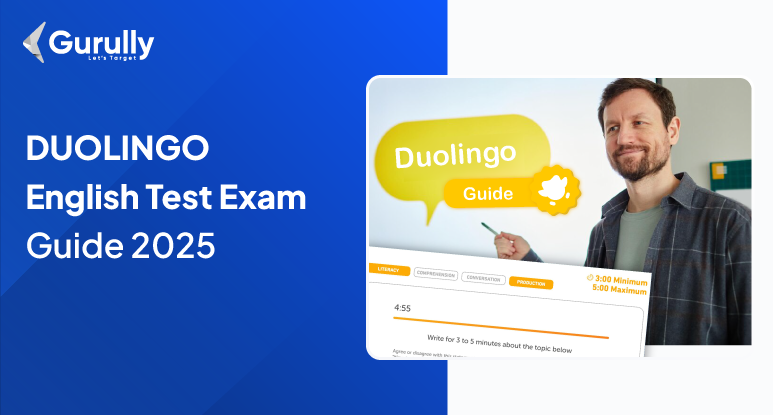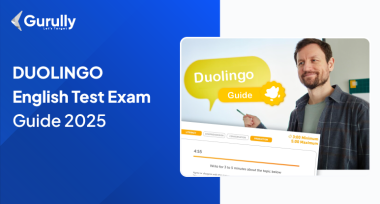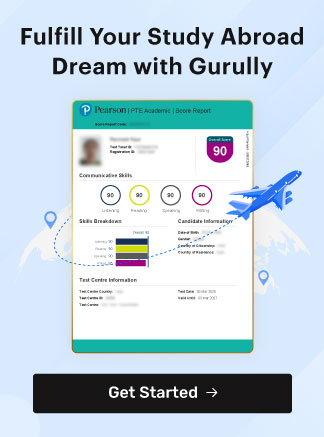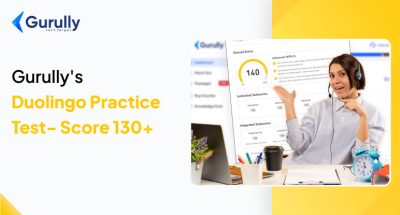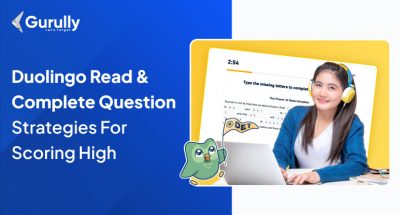The DUOLINGO English Test (DET) is a widely accepted standardized assessment that verifies English language skills. Over a thousand universities across 100+ countries recognize the DET for various purposes, including admissions, academic placement, tracking progress, and fulfilling graduation requirements. So, if you plan to take this exam, here is then in-depth details about the Duolingo English Test question type that you need to get familiar with for 2025.
Duolingo English Test Question Type (Format)
- Literacy: This section tests your ability to understand written English in various contexts. You might encounter tasks like reading news articles, emails, social media posts, or short stories and then answering questions that require you to grasp the main idea, identify specific details, make inferences, or understand the tone and purpose of the writing.
- Production: This assesses your ability to speak English fluently and communicate your ideas. You might be shown a picture, given a short prompt, or asked to read a short passage. Production tasks can also assess your ability to organize your thoughts and speak coherently for a brief period.
- Comprehension: This tests your ability to understand spoken and written English. You might be asked to listen to a conversation or passage and then answer questions about its main points, details, or supporting arguments.
- Conversation: This category examines your ability to understand spoken English and respond appropriately. You might be shown a picture or given a short prompt and asked to discuss it, combining listening and speaking skills.
What is the Duolingo English Test?
The Duolingo English Test is a computer-adaptive, high-stakes English proficiency test designed to assess a candidate’s ability to use the English language. It is an affordable and convenient digital-first test accepted by thousands of universities and millions of students worldwide. The test evaluates a candidate’s reading, writing, listening, and speaking skills in English, making it a comprehensive assessment of English proficiency.
Unlike traditional tests, the Duolingo English Test is taken online, allowing candidates to complete it from the comfort of their own homes. This Duolingo English test pattern makes it an attractive option for international students and professionals who need to demonstrate their English language skills for academic or career purposes. The test is designed to be user-friendly, with a straightforward interface and clear instructions, ensuring that candidates can focus on showcasing their English proficiency.
Duolingo English Test 2025 Overview
The Duolingo English Test 2025 is a standardized test that measures English language proficiency. It serves as a convenient alternative for international students looking to fulfill English proficiency requirements for academic institutions. The test is computer-adaptive, meaning the difficulty of questions adjusts based on the candidate’s responses. This adaptive nature ensures a precise measurement of the candidate’s English skills.
The test includes a variety of question types, such as multiple-choice questions and open-ended questions, to assess both spoken and written English skills. Candidates will also have the opportunity to record a video interview and write a sample, providing a comprehensive evaluation of their English proficiency. All questions are graded by a computer, ensuring a quick and unbiased assessment.
The Duolingo English Test is widely recognized by academic institutions, employers, and other organizations for verifying English proficiency. It is used for admissions, job interviews, and applicant verification, making it a versatile tool for anyone needing to demonstrate their English language skills.
Pattern of Duolingo English Test Question Type
Read and Select:
In these Duolingo question types, your Literacy skills are being evaluated.
- You’ll see a list of words appear on the screen.
- Identify the actual English words from the list.
- Pay close attention when the timer starts. Specific instructions will appear, reminding you to examine each word carefully.
Fill in the Blanks:
- Focus: Vocabulary & Grammar in Context
- Task: Complete individual sentences with a single missing word.
- Goal: Choose the word that makes the sentence grammatically correct and conveys the intended meaning.
Read & Complete:
- Task: Complete a written passage with missing letters.
- What you see: A passage with words having blank spaces for missing letters.
- What you do: Read the passage and use context clues to figure out the missing letters.
- Goal: Fill in the blanks with the correct letters to complete the words and the whole passage.
Read Aloud:
For the question “Read, then Speak”, you’ll see a written statement on the screen.
These Duolingo question types offer a unique opportunity to demonstrate your spoken English skills in a flexible and convenient manner.
- Speak, Not Read: Ignore the instruction “Record yourself saying the statement below.” This doesn’t mean you read it!
- Speak Your Thoughts: Use the prompt as a springboard to speak your own thoughts for at least 30 seconds (up to 90 seconds total).
- Microphone Ready: Prepare to speak into the microphone about the prompt, not read it word-for-word.
Listen & Type:
- Task: Listen and Type
- Goal: Test your accuracy in transcribing spoken English.
- Instructions:You’ll hear a clear statement spoken aloud.
- Once you’ve listened to the entire statement, type it out exactly as you heard it.
- Skills Assessed: Listening comprehension and typing skills
Complete the Sentences:
- Task: Fill in the blanks of a written passage.
- Goal: Choose the word that best fits the context.
- Focus: Both grammar and meaning.
- Consider How the chosen word fits the overall flow of the passage
Complete the Passage:
- Task: Fill in the blank space in a reading passage.
- What you see: A reading passage with a single missing sentence.
- Your goal: Choose the best sentence to complete the passage logically and smoothly
Highlight the Answer:
- You’ll see a question displayed on the screen.
- Read a provided passage.
- Find the answer to the question within the passage itself.
- Use your mouse or cursor to drag and highlight the text containing the answer.
- The highlighted section will appear in a separate box for confirmation.
Identify the Idea:
- This task focuses on identifying the central idea of a reading passage.
- You’ll be presented with a passage and several answer choices.
- Your goal is to select the option that best captures the main point of the entire passage.
Title the Passage:
- Task: Choose the best title for a passage.
- Information Provided: A list of title options.
- Goal: Identify the title that best summarizes the passage’s main idea or central theme.
Listen & Respond:
- Prompt: You see a written prompt on the screen, a topic you’ll need to discuss.
- Read Time: You have a short time (usually around 20 seconds) to read and understand the prompt.
- Speak Time: You record your spoken response for at least 30 seconds, with a maximum of 90 seconds.
- Focus: You speak about the prompt itself, not following conversation starters.
Summarize the Conversation:
- Listen Up: The DUOLINGO English Test (DET) will play a conversation for you.
- Summarize Smartly: After listening, write a summary that captures the key points of the conversation.
- Focus on the Essentials: Aim for a concise summary that conveys the main ideas without unnecessary details.
Write About the Photo:
- Focus: Describe an image on the screen.
- Task: Write a paragraph or so detailing the image.
- Time Limit: 1 minute.
Interactive Writing:
- The Interactive Writing section of the Duolingo English language test pattern is a two-step challenge designed for creativity.
- Step 1: You’ll see a written prompt and have 5 minutes to respond. The prompt can be anything from a story starter to a thought-provoking question.
- Step 2: Based on your initial response, you’ll receive a brand new “follow-up prompt.” This prompt aims to take your story or idea in a fresh direction.
Listen, Then Speak:
- The “Listen, Then Speak” section of the DET tests your spoken English skills.
- You’ll first hear and see a prompt on a specific topic.
- You’ll have 20 seconds to review the prompt on screen and listen to it repeatedly.
- After 20 seconds, the recording will begin, and you’ll have 90 seconds to speak your thoughts on the topic.
Speak About the Photo:
- See an image on the screen for 20 seconds.
- Talk about the image for 90 seconds (recording starts automatically after 20 seconds).
- Option to start recording earlier by clicking “NEXT.”
- Minimum speaking time of 30 seconds, but using the full 90 seconds is recommended
Read, Then Speak:
- “Read, Then Speak” section: You’ll see a written prompt on the screen.
- Task: Speak about the prompt for at least 30 seconds (up to 90 seconds total).
- Preparation: Take 20 seconds (approx.) to read and understand the prompt.
- Delivery: Record your spoken response using the microphone.
Writing Sample:
- This is a timed writing task in the DET.
- You’ll see a written prompt on the screen for 5 minutes.
- Don’t rush! You get a 30-second planning phase before the timer starts.
- Use those 30 seconds to read the prompt carefully and brainstorm your ideas.
Speaking Sample:
- The Speaking Sample on the DET tests your ability to speak about a specific topic.
- You’ll see a written prompt displayed for 30 seconds.
- Use this prep time to read and understand the topic.
- After 30 seconds, you’ll have 3 minutes to speak about the prompt.
How Scoring is Done in the DUOLINGO English Test Pattern:
Know in depth about how scoring is done in all Duolingo English test question types:
Automatic Scoring:
- A computer program grades these questions (such as “Read and Complete” or “Listen and Type”).
- The program compares your answer to the correct answer and awards points based on their proximity.
- Good news! You don’t get penalized more for a wrong answer than skipping the question entirely.
- Depending on the question type, you might even get some points for an incorrect answer.
- Tip: Always try to answer these questions, even if unsure!
Open Response Scoring:
- These questions (like “Write About the Photo” or “Speak About the Photo”) involve writing or speaking a response.
- Here, a computer program called a “grading engine” evaluates your answer. It’s like having a super-smart computer judge who understands English really well!
- The engine looks at several things:
- Content: Does your answer make sense for the prompt? Is it well-developed and exciting?
- Organization: Is your writing/speech clear and easy to follow? Do your ideas flow smoothly? (For writing type questions only)
- Vocabulary: Do you use a variety of words effectively? (For writing type questions only)
- Grammar: Are your sentences grammatically correct? (For writing type questions only)
- Fluency (Speaking): Do you speak smoothly and naturally? (For speaking type questions only)
- Pronunciation (Speaking): Is your pronunciation clear and easy to understand? (For speaking type questions only)
How To Book DUOLINGO Exam:
To take the DUOLINGO English Test (DET):
- Log in to your existing account at https://englishtest.duolingo.com
- If you don’t have an account, sign up for free with a valid email address by this link: https://englishtest.duolingo.com/invite/VFYZ6T63.
- In the “Purchase the Test” section, click “BUY NOW.”
- Fill out the online checkout information using a major credit card or other accepted payment methods.
- Apply a coupon code if provided by an institution.
- You have 21 days to start the test after purchase.
- You can take the Duolingo English Test from the comfort of your home at any time within the specified period.
- You can buy up to 3 tests within 30 days.
Who can Take the DUOLINGO Exam:
The Duolingo English Language Test is open to everyone who wants to demonstrate their English language skills! Here’s a breakdown of who can take the test:
Age: There’s no minimum requirement, but testers under 13 need parental consent. Parents or guardians can permit an online form during registration.
Academic Background:
- No specific academic qualifications are required.
- Anyone can register, pay the fee, and take the test.
Test Day Requirements:
Before you take the DET, make sure you have:
- Valid ID (passport, driver’s license, government ID)
- A quiet, well-lit room
- 60 minutes of uninterrupted time
- Reliable internet connection
- Computer (Windows or macOS)
- Front-facing camera
- Microphone
- Working speakers
Exam Preparation Tips For DUOLINGO
- Understand the test: Familiarize yourself with the sections (Literacy, Production, Comprehension, Conversation) and Duolingo English test question types (Read & Complete, Listen & Type, Speak About the Photo, etc.). This will help you manage your time effectively during the test.
- Practice sample questions: DUOLINGO offers free practice tests online. Utilize these resources to get a feel for the format and difficulty level of the actual exam.
- Reading: Read various English materials, such as news articles, novels, or blogs. This will enhance your vocabulary and comprehension skills.
- Writing: Practice writing regularly in English. You can start a journal, write short stories, or respond to prompts online.
- Listening: Immerse yourself in English audio. Watch movies and TV shows, and listen to podcasts or audiobooks. Focus on understanding the spoken language and different accents.
- Speaking: Find opportunities to speak English. Join conversation groups, practice with friends, or use language learning apps focusing on speaking.
- Get a good night’s sleep: Being well-rested will improve your focus and concentration during the exam.
- Choose a quiet, distraction-free environment: Minimize background noise and interruptions to ensure optimal test-taking conditions.
- Manage your time effectively: Allocate time for each section based on the number of questions and your strengths. Don’t dwell on a question for too long.
- Mock Test: Mock tests are timed, just like the DET, so you can practice answering questions within the allocated time frame. This helps you develop your pacing skills and avoid spending too much time on any one question.
Know how to prepare for DUOLINGO in 7 Days.
Gurully goes beyond essential practice by offering a streamlined experience that closely mimics the real DET. Their platform features realistic exam simulations with authentic mock test content. These practice tests mirror the questions you’re likely to see on the exam, giving you a significant edge. By taking these practice tests, you can identify areas where you need improvement and gain valuable confidence by familiarizing yourself with the DUOLINGO Exam Pattern and question style.
Conclusion:
This comprehensive guide has equipped you with everything necessary to excel in the Duolingo English test question types. We’ve explored the exam format, delved into different question types, and even provided insights into the scoring process. Now, you clearly understand the DET and how to approach it confidently.
Remember, the key to success lies in preparation. Utilize online resources and practice sample questions to hone your reading, writing, listening, and speaking skills. By familiarizing yourself with the format of Duolingo English test question types and actively improving your English proficiency, you’ll be well on your way to achieving a stellar score.
Also Read:
- Your Guide to Duolingo English Test Fee – 2025
- Speak About the Photo Duolingo – 50 Examples, Sample Answers, Templates, and Hacks
- Duolingo Read Aloud Task – Tips To Score High With Practice Questions
Useful Pages for DET Test Takers:

